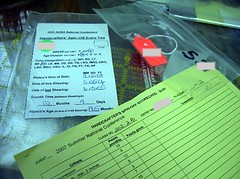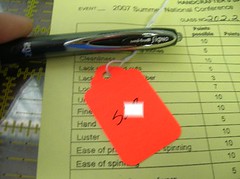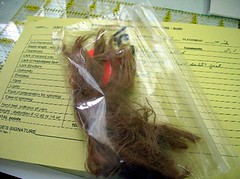Friday, March 30, 2007
Tuesday, March 20, 2007
Just showing off a little
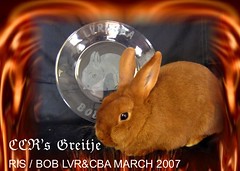 I attended the Lehigh Valley Rabbit Breeders (LVR&CBA) show in Hamburg PA this past Saturday. We had about 12 inches of snow the day before so I wasn't real keen on taking a whole slew of rabbits, but Thriantas are so easy so I took 2 bucks and a doe. It was a double show and the same doe, CCR's Greitje, took BOB both shows! Even better, she took
I attended the Lehigh Valley Rabbit Breeders (LVR&CBA) show in Hamburg PA this past Saturday. We had about 12 inches of snow the day before so I wasn't real keen on taking a whole slew of rabbits, but Thriantas are so easy so I took 2 bucks and a doe. It was a double show and the same doe, CCR's Greitje, took BOB both shows! Even better, she took RESERVE IN SHOW in Show B! Judge Paul Kyle awarded her the BOB and Judge John Soper awarded her the RIS. Judge RuthAnn Bell awarded her BOB in show A. There were between 1200 and 1500 entries and the show was sanctioned with the ATRBA. Yah!
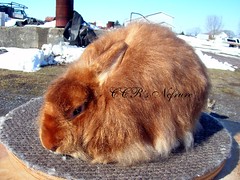 Not to be outdone back at home, CCR's Nefrure a Red Satin Angora Sr Doe wanted to show that Thriantas aren't the only fireballs around here. Gotta love RED.
Not to be outdone back at home, CCR's Nefrure a Red Satin Angora Sr Doe wanted to show that Thriantas aren't the only fireballs around here. Gotta love RED.
Monday, March 12, 2007
Alpaca judging step 2
So today I'm presenting the next stage of my process but the first stage of the actual judging. I do find this step to be a bit tedious but it's so very important! The Handcrafter's Spin Off is intended to represent sending your best alpaca fiber to handspinners for a premium price. Imagine that I, as a handspinner, has requested a 2 ounce sample of your alpaca. I am looking for a source for alpaca fiber and I know that I'll pay premium price for the best. How will the breeder/shepherd respond to my request? Will they grab the first handful or two on the top of whatever bag of fleece and jam it into a bag? Or will they skirt out the finest fiber from the better fleeces, prepare it carefully and present it to me like the premier fiber it is reported to be? This first part of the scoring is all about that presentation and quality. The way this contest is judged, a fiber seller could well use the scores to advertise to spinners the quality of their services and product. I know of one breeder who scored exceptionally well and sold the judged fleece for over $500!!! directly because of the scorecard. You can easily imagine the effect on the stud's breeding schedule.
Note: Unless otherwise noted, I have not chosen the photos because of their quality. I'm simply showing a random example. I've also blanked out entry numbers for the sake of privacy.
 The first Judging criteria is First Impression. I look at the packaged sample before ever touching it. Is it presented well? Was time and care taken in selecting and preparing the sample? Is the fiber in good condition; not dirty, matted or messy? Can I easily sort the fiber for spinning? This is one step that can make or break a contest. ALL fiber can be presented well or poorly and that is the FIRST impression you make to your buyer! Mediocre fiber will sell for more if it is presented well and outstanding fiber will sell for less if you look like you couldn't care less how you treat your customer. There is simply no excuse for jamming a random sample in a bag and expecting people to pay top dollar.
The first Judging criteria is First Impression. I look at the packaged sample before ever touching it. Is it presented well? Was time and care taken in selecting and preparing the sample? Is the fiber in good condition; not dirty, matted or messy? Can I easily sort the fiber for spinning? This is one step that can make or break a contest. ALL fiber can be presented well or poorly and that is the FIRST impression you make to your buyer! Mediocre fiber will sell for more if it is presented well and outstanding fiber will sell for less if you look like you couldn't care less how you treat your customer. There is simply no excuse for jamming a random sample in a bag and expecting people to pay top dollar. An important observation at this point is looking for parasites. If ANY infestation is found, the sample is placed in the freezer for a few days. If I suspect the infestation is active and poses any threat to my own home and fiber stash, I remove that sample from my home and double bag it. You send any spinner a sample with parasites in it and you won't only lose their business, they will make sure that all their friends know not to buy from you! Spinners will not sacrifice or risk their own precious fiber collection no matter how good your alpaca is.
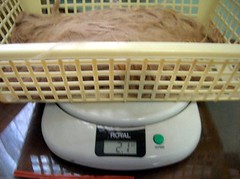 Every sample is weighed. Was the correct amount of fiber sent? If you sent less, did you overcharge me? If more, did you charge me for more than I asked?
Every sample is weighed. Was the correct amount of fiber sent? If you sent less, did you overcharge me? If more, did you charge me for more than I asked? 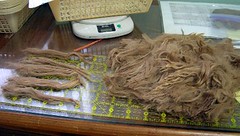 Points are also given for staple length with a minimum of 3 inches required. 5-7 locks are chosen from all over the sample. There are no extra points for a particular length of staple, but are the lengths CONSISTENT? It's rare to find all staples exactly the same but they should be very, very close. Points are deducted based on percentage of difference. a 1 inch difference between 3 and 4 inches is much more severe than between 11 and 12 inches. A very important evaluation is for fiber that is sound and has no tender breaks or weak tips. Either of these things can ruin an entire fleece by creating noils and pills in the resulting yarn.
Points are also given for staple length with a minimum of 3 inches required. 5-7 locks are chosen from all over the sample. There are no extra points for a particular length of staple, but are the lengths CONSISTENT? It's rare to find all staples exactly the same but they should be very, very close. Points are deducted based on percentage of difference. a 1 inch difference between 3 and 4 inches is much more severe than between 11 and 12 inches. A very important evaluation is for fiber that is sound and has no tender breaks or weak tips. Either of these things can ruin an entire fleece by creating noils and pills in the resulting yarn. Cleanliness is also very important and allocated 10 points. Now, washing the fiber is absolutely prohibited but there are things a fiber provider can do to minimize dirt. Separating, blowing, stroking and picking out short cuts is all expected. If this is done then the only dirt left will be some dust within the staple structure itself. How do you reduce that? Do not use overhead feeders to keep hay and chaff (this is VM = Vegetative Matter) out of the fleece. Keep pastures green and clean of bushes and trees that shed seed pods. Use hay that does not include seed heads!!!! Keep animals out of pastures that include mud and clay if at all possible. I have actually seen fleeces where the tips were clogged with what appears to be TAR. Whatever?!
Cleanliness is important because ideally, alpaca should be able to be spun without washing first. That will be more clear as I show you the next step of the judging in a few days.
Another criteria is Lack of second cuts. Second cuts happen when the blade goes back over the same area more than once. I have noticed that as the popularity of using Fiscar shears to do the shearing themselves, the incidence of severe second cuts has increased dramatically. The worst of these is mid staple cuts. Let's say you have fiber with a 5 inch staple. If you cut it down the middle, you know have 2 staples of 2.5 inches and that is 100% wasted fiber. At best you have very inconsistent staple length which no spinner wants.


Next is judging the fiber itself. Lack of medullated fibers, lock structure, Uniformity, Fineness, Hand, Luster. These are all traits that have everything to do with the genetics of the animal and less to do with husbandry.
Some specific notes:
Lack of medulatted fiber - these are the especially coarse fibers usually in the center of the lock of fiber. These fiber tend to stick out of the yarn like barbs on a wire fence.
Lock structure - Fleeces that are more dense will tend to keep staples distinct and separate. Locks that are open and loose will be prone to cotting and matting at the base near the skin. This cotting makes the fiber miserable for a spinner to process. On the other hand, a lock that is very tightly twisted together is also very difficult to open up without breaking the strands and creating noils and pills in the yarn.
Uniformity - this includes Lock and Fiber style, color, texture, crimp (huacaya only) and color. If a sample has much variety in any of these features it will diminish the quality of the resulting yarn.
Fineness - slightly obvious. Finer fiber is generally softer.
Hand - even fine fiber can be dry, brittle and fragile. Alpaca should be very soft and Suri should be distinctly silky. Healthy fiber should feel robust and stable.
Luster - I choose to break this scoring into two parts, one before spinning and one after the yarn is complete and washed. The presence of dust (alpacas are dust bathers) can hide the luster that is still present. The luster on the animal is important but the end result is even more important. I try very hard to balance that.
So now I check that all the information is correct, that the cards are filled out and legible.
I add a tag to the package because that is how I identify the skein after it's spun. Incidentally, I learned something about the pens I use. I was just looking for a pen that was resistant to running and bleeding if it gets wet. What I found was that this particular pen is designed to be resistant to solvents. According to the packaging, a current method of fraud is 'washing' checks to remove the written dollar amount and fill in a fraudulent amount. Wow, and I thought that just using ink was enough. Apparently not. 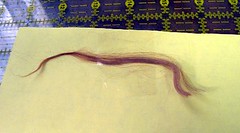

If there was something particularly notable about a sample, such as the presence of kemp fiber, mid-staple cuts, infestation, tender breaks...I will attach a sample and perhaps a brief explanation to the back of the score card. I go on the assumption that the breeder wants to learn about their fiber and would welcome an explanation. I also sometimes will include positive info on the back especially if it's unrelated to the judging. Perhaps something amusing about the sample (certain lock types give me the giggles they are so cute) or a color that really strikes me aesthetically. It's not taken into account in the scoring, but it might mean something to the breeder.
Now the sample locks and tag are placed in the marked small baggie and set aside with the corresponding score card in a small bin for that class. I process ALL the breed (Suri or Huacaya) samples before moving onto the next step of judging. This gives me the chance to forget any prejudices I might have about one sample or another. Trust me; after this process on 100 samples, I do NOT remember that one really awesome fawn sample. I'm lucky to remember my NAME.
So today, onto the next step of the process; combing and spinning the samples into a yarn. Until next time....
Friday, March 09, 2007
Thursday, March 08, 2007
Judging Alpaca
Here I am starting another judging assignment for the AOBA. I judge the Handcrafter's Spin Off contest for the national and a couple of state Alpaca shows and I just LOVE this job. I find this to be absolutely one of the best contests to evaluate the quality and marketing of luxury fiber to handspinners. The way this contest is structured a handspinner could really use the results to choose a great fleece to purchase and a great SHEPHERD to work with.
I'm going to try to post periodic updates about the judging process and what goes into this awesome job of mine. Now, I have to be totally honest here; much of this will probably be about my own neurotic ways and opinions, both of which I have in excess. :)
OK, the first step: Receiving the samples.
Th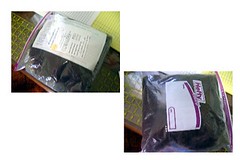 is is the first step for ME, but by no means the first step in the process. Before the samples arrive at my doorstep, they are received and processed by the supervisor of this particular contest. She receives the sample from the exhibitor, she checks the information for accuracy and completeness. The exhibitor lists the age of the animal in years and months, they list the number of months the sample fiber has been growing and the date of the last shearing. The color classification is checked against the AOBA show standard and they will attempt to eliminate any really flagrant disqualifications such as infestation. The supervisor will then remove ALL identifying material from the sample so that I - the judge - has no way of knowing who sent in the entry. Entry numbers are assigned, and judging forms are filled out and included in the sample entry bag. Then the entries are sorted into classes, packed into boxes and mailed to me.
is is the first step for ME, but by no means the first step in the process. Before the samples arrive at my doorstep, they are received and processed by the supervisor of this particular contest. She receives the sample from the exhibitor, she checks the information for accuracy and completeness. The exhibitor lists the age of the animal in years and months, they list the number of months the sample fiber has been growing and the date of the last shearing. The color classification is checked against the AOBA show standard and they will attempt to eliminate any really flagrant disqualifications such as infestation. The supervisor will then remove ALL identifying material from the sample so that I - the judge - has no way of knowing who sent in the entry. Entry numbers are assigned, and judging forms are filled out and included in the sample entry bag. Then the entries are sorted into classes, packed into boxes and mailed to me.
Now the Postal Lady delivers them to Me!!!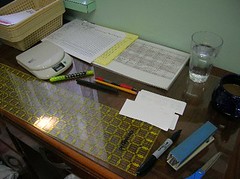
And here is my first obsession. I have very specific tools I need and I have to have just the right stuff.
*Scale to weigh every sample in ounces (2 oz is the requirement)
*Pencil to record ongoing scores on the judging sheet - I have ONE style of mechanical pencil I'll use. The yellow Bic pencil with the cone that turns. I don't like the clicker style. I tore the house apart before I found ONE pencil to my satisfaction and then it was nearly empty. That required a trip to WalMart.
*felt marker to mark plastic bags
*Paper labels and stapler to re-label bags to my satisfaction
*Highlighter and red pen to remind me of things I need to remember about my scoring.
*Coffee - that doesn't really need explanation does it?
*Bins for sorting classes
*Detail judging score outlines. I literally assign specific score numbers to various traits. This is the best way I know to judge OBJECTIVELY when appropriate.
*Clear ruler to measure staple length of every sample entry.
Now, do I sound like I want things to be 'just so'? That would be correct, so what do I see when I open the boxes?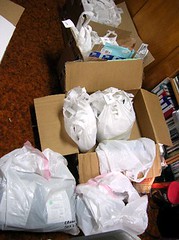
I'm going to try to post periodic updates about the judging process and what goes into this awesome job of mine. Now, I have to be totally honest here; much of this will probably be about my own neurotic ways and opinions, both of which I have in excess. :)
OK, the first step: Receiving the samples.
Th
 is is the first step for ME, but by no means the first step in the process. Before the samples arrive at my doorstep, they are received and processed by the supervisor of this particular contest. She receives the sample from the exhibitor, she checks the information for accuracy and completeness. The exhibitor lists the age of the animal in years and months, they list the number of months the sample fiber has been growing and the date of the last shearing. The color classification is checked against the AOBA show standard and they will attempt to eliminate any really flagrant disqualifications such as infestation. The supervisor will then remove ALL identifying material from the sample so that I - the judge - has no way of knowing who sent in the entry. Entry numbers are assigned, and judging forms are filled out and included in the sample entry bag. Then the entries are sorted into classes, packed into boxes and mailed to me.
is is the first step for ME, but by no means the first step in the process. Before the samples arrive at my doorstep, they are received and processed by the supervisor of this particular contest. She receives the sample from the exhibitor, she checks the information for accuracy and completeness. The exhibitor lists the age of the animal in years and months, they list the number of months the sample fiber has been growing and the date of the last shearing. The color classification is checked against the AOBA show standard and they will attempt to eliminate any really flagrant disqualifications such as infestation. The supervisor will then remove ALL identifying material from the sample so that I - the judge - has no way of knowing who sent in the entry. Entry numbers are assigned, and judging forms are filled out and included in the sample entry bag. Then the entries are sorted into classes, packed into boxes and mailed to me.Now the Postal Lady delivers them to Me!!!

And here is my first obsession. I have very specific tools I need and I have to have just the right stuff.
*Scale to weigh every sample in ounces (2 oz is the requirement)
*Pencil to record ongoing scores on the judging sheet - I have ONE style of mechanical pencil I'll use. The yellow Bic pencil with the cone that turns. I don't like the clicker style. I tore the house apart before I found ONE pencil to my satisfaction and then it was nearly empty. That required a trip to WalMart.
*felt marker to mark plastic bags
*Paper labels and stapler to re-label bags to my satisfaction
*Highlighter and red pen to remind me of things I need to remember about my scoring.
*Coffee - that doesn't really need explanation does it?
*Bins for sorting classes
*Detail judging score outlines. I literally assign specific score numbers to various traits. This is the best way I know to judge OBJECTIVELY when appropriate.
*Clear ruler to measure staple length of every sample entry.
Now, do I sound like I want things to be 'just so'? That would be correct, so what do I see when I open the boxes?

Now, mind you, the show super already did a great job of organizing and sorting these classes, but..... some are in grocery bags, some in white plastic trash type bags, some of the grocery bags are {GASP} not white! Oh! the humanity!!!
So the first thing that *I* do is re-sort and re-organize. I use white grocery bags, I relabel them with the class number and the number of entries in that class. This helps me to organize my time and keep track of what is supposed to be in that bag. 

The advantage is that when I put all these bags back into boxes I can easily see what is what just by looking at the top of the box.
This also gives me the opportunity to eyeball all the entries to do a quick once over and look for infestations. I'm sorry, but it does happen. I have lost some valuable fleeces of my own from taking in fiber samples that didn't 'blossom' their cargo until a week or two later. I have also learned not to leave samples sitting around with the ziplok bags unsealed. If a bag zipper breaks, it gets a new bag. Wanna know the most sturdy brand of sealed plastic bags? just ask! 

And this is what I end up with. Orderly, easy to work with, easy on the eyes and ready for the next step. Up to now, NO actual evaluation of the samples has taken place. This has been all about me and making my job easier. :)
HAPPY BIRTHDAY CITH!!!

It's the Cat In The Hat's 50th Birthday!
This is really big stuff. The Cat was created 50 years ago on a dare in an effort to bring life and fun to learning to read. Books of the time were just so dry and "un-fun" and reading was at an all time low among young children. Thanks to Dr Seuss (aka Theodor Seuss Geisel) many children found a whole new reason not only learn to read, but to learn to read with enthusiasm. He introduced creativity, suspense, chaos, cadence and imagination to generations of children through his amazing characters and antics.
Now you can say THANK YOU and introduce the gift of reading to underprivileged children through the Cat In The Hat. Visit the birthday website HERE and send a FREE birthday card to Mr. Cat. For every e-card sent, Random House Children's Books will donate one book to First Book (up to 1,000,000 books) of any Seuss Random House Children's Book purchased between January 9, 2007 and May 1, 2007. So go send a free card to the Cat and a book and the gift of reading to a child.
Happy Birthday Mr Cat!!!!
Monday, March 05, 2007
Roasted with thyme please...
{sigh} here I am dining on crow....AGAIN.
So I went to a nice rabbit show this weekend in York PA. Good show! Good judges, lots of nice people and a dear friend won BIS with a really GORGEOUS black New Zealand. Not a variety/breed known for such high quality so that was a real accomplishment! Big Congrats Fred!
Things were going just fine and I was having a nice visit with other friends Eric and Michael. They had their dogs with them. First I saw the darling Papillon running around and I just love those guys. They are one of those breeds that don't realize that they are only 18 inches tall. Then out runs Eric's two prize dogs and I exclaimed "Oh, I just LOVE min-pins!" (which I thought I did) A-hem.... they are Manchesters. Lesson #1 in offending your friends down to the heart: Mistake their high quality show dogs for the WRONG BREED. Works every time. I was MORTIFIED! It's ok, I'm accustomed to humiliation as I have a long-standing relationship with it based on familiarity. ugh.
OK, so my new favorite is MANCHESTER TERRIERS! Honestly, they really do have exactly the look I thought I loved about the min-pins and Eric's were fine examples. Very nice dogs.
So if you'll excuse me, I need some whine (sic) to wash down that crow. :)
Oh, I'm not reporting any show wins because I didn't take so much as the first rabbit along with me. Yeah. Imagine that. I went to a rabbit show just to visit, write for judges and study breeds. I really did have a good time!
So I went to a nice rabbit show this weekend in York PA. Good show! Good judges, lots of nice people and a dear friend won BIS with a really GORGEOUS black New Zealand. Not a variety/breed known for such high quality so that was a real accomplishment! Big Congrats Fred!
Things were going just fine and I was having a nice visit with other friends Eric and Michael. They had their dogs with them. First I saw the darling Papillon running around and I just love those guys. They are one of those breeds that don't realize that they are only 18 inches tall. Then out runs Eric's two prize dogs and I exclaimed "Oh, I just LOVE min-pins!" (which I thought I did) A-hem.... they are Manchesters. Lesson #1 in offending your friends down to the heart: Mistake their high quality show dogs for the WRONG BREED. Works every time. I was MORTIFIED! It's ok, I'm accustomed to humiliation as I have a long-standing relationship with it based on familiarity. ugh.
OK, so my new favorite is MANCHESTER TERRIERS! Honestly, they really do have exactly the look I thought I loved about the min-pins and Eric's were fine examples. Very nice dogs.
So if you'll excuse me, I need some whine (sic) to wash down that crow. :)
Oh, I'm not reporting any show wins because I didn't take so much as the first rabbit along with me. Yeah. Imagine that. I went to a rabbit show just to visit, write for judges and study breeds. I really did have a good time!

